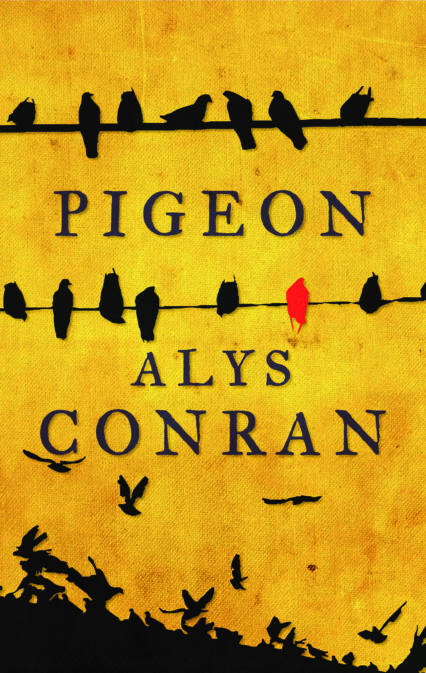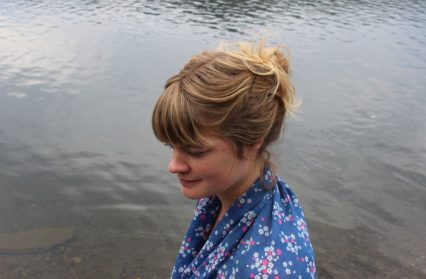Bill Rees reviews Pigeon, the debut novel from Alys Conran, and finds a narrative that is “thoroughly engaging” and “heart wrenching”.
Pigeon, the novel’s eponymous anti-hero, is a skinny boy with shoulders as ‘delicate as egg shells’ and who has a taste for ice cream, tobacco and adventure. Not the Boy’s Own sort. That we soon learn because, like an R.S. Thomas poem, this story unfolds in North Wales and utterly debunks the myths of a rural (childhood) idyll. Absolutely nothing about the landscape, the characters and the plot of Pigeon is, to quote the great poet, ‘arranged romantically in the usual manner.’
 The village of the novel is unnamed, but from description of the mountains, the slate quarries and the stated close proximity of Lanfairfechan, I deduce it to be Bethesda near Bangor. This might help to explain why Alys Conran’s story evokes a little of the disconcerting atmosphere of Un Nos Ola Leuad (One Moonlit Night). The similarities – to Caradog Pritchard’s classic novel – aren’t confined to geographical ones either, for we have choirs in grey stone chapels, absent fathers, mentally unstable personages, and a narrative voice that is at once poetic and touchingly naïve. It mostly belongs to Pigeon’s best friend, Iola Williams who describes their impoverished upbringings and escapades with unflinching honesty. Iola’s personal account is interspersed by a third person narrative mode, which is of similar syntax and, for the most part, inflected with Iola’s sensibilities.
The village of the novel is unnamed, but from description of the mountains, the slate quarries and the stated close proximity of Lanfairfechan, I deduce it to be Bethesda near Bangor. This might help to explain why Alys Conran’s story evokes a little of the disconcerting atmosphere of Un Nos Ola Leuad (One Moonlit Night). The similarities – to Caradog Pritchard’s classic novel – aren’t confined to geographical ones either, for we have choirs in grey stone chapels, absent fathers, mentally unstable personages, and a narrative voice that is at once poetic and touchingly naïve. It mostly belongs to Pigeon’s best friend, Iola Williams who describes their impoverished upbringings and escapades with unflinching honesty. Iola’s personal account is interspersed by a third person narrative mode, which is of similar syntax and, for the most part, inflected with Iola’s sensibilities.
Iola allows herself to be seduced by Pigeon’s fantasy world and so plays a role in his ‘five stage plan’ to prove that Gwyn, the unprepossessing man with the ice cream van, is up to no good. A murderer even! Both plan and van (in a physical sense) go awry, and someone is seriously injured in the process.
The book’s main epigraph is a quotation from Simon Barnes’ The Bad Birdwatcher’s Companion, which notes that a pigeon is ‘the most obvious bird but that don’t even rate a mention.’ In this respect Alys Conran sees an analogy between pigeons and people, the dispossessed and desperate sort who are seldom noticed, let alone given a voice that is both authentic and complex. The cryptically attuned reader is thus prepared for the kind of territory which film critics used to call gritty realism.
Iola lives with Efa, a yoga practicing elder sister who has taken on a maternal role. Their father has left, their mother has died (cancer), and so too has Nain, after having (to make up for her son’s short comings) ‘moved in with rules, dinner on the table and bed time like a stone wall.’ I loved the lines like this, and believe the novel works best when its prose is both poetic and believably that of a bright and observant school girl.
Efa, who has a penchant for hippy dresses and herbs, is making the best of a difficult situation, and Iola feels loved and cared for. Their relationship is sympathetically portrayed. There are some winning descriptions of their household; the energy of cooking and doing things, which makes for a stark contrast to the goings-on (or non-goings on) in the TV dominated house where Pigeon resides. It isn’t really a home; the sallow faced boy even made to sleep in the unheated shed. The attic is Pigeon’s other place of refuge, where he smokes and reads and schemes in secret; only Iola being privy to Pigeon’s fascination with, and sensuous feel for, language. He is a collector of words, filling his mouth ‘with their strange textures: clay, metal, soap textures, and the strange tastes of the words as he says them into the cold air.’
Pigeon is loved by Mari Davies, his pretty, seamstress mother, but she struggles to express her affections, and she is quite unable to resist the bullying antics of Adrian, her boyfriend from England. He has moved into their ‘crooked house’ on the ‘grey hill’, bringing to it his daughter (the personable Cher), his prejudices and an ever present threat of violence. He seems almost to prey upon Pigeon’s mother, sucking the spirit of creativity and independence out of her.
By playing truant, Pigeon exercises a form of freedom, which can only be found outside school and the home. A victim of chronic material and emotional poverty, Pigeon is understandably angry and troubled. It is (his) misdirected fury that results in an arson attack. And soon afterwards, Adrian is actually killed (shot) with Pigeon deemed guilty of the crime. Sent to a borstal in England, Pigeon is also shackled linguistically, since Welsh there is a thoroughly foreign language. But as Iola knows, Pigeon is nothing if not resourceful. He has mastered English by the time of his release. And when he returns home, those once delicate shoulders have hardened and he is disinclined to speak his mother tongue. He becomes a Heathcliffian, unruly presence; at one with the elements, striving to take control of a life that continues to pose immense challenges. His mother is sinking ever deeper into depression and debt, and before ending up in a psychiatric hospital, she resorts to prostitution. Meanwhile, Iola is discovering that her sister’s boyfriend, Dafydd is a phoney and capable of blackmail.
But such grimness is effectively countered by the re-kindling of the relationship between Iola and Pigeon, which is realistically drawn out and most affecting. Towards the novel’s end, Pigeon also encounters Elfyn, a long awaited father figure with whom he rediscovers a willingness to speak Welsh. Elfyn is a gentle soul who helps Pigeon to develop the skills for building dry stone walls. At last Pigeon achieves a semblance of serenity and a feeling of liberation, which is ironical given the nature of his new found passion.
Welsh characters, Welsh setting, smatterings of dialogue in printed Welsh, an undeniably Welsh novel then but it is written in English, a ‘sludgy’ language according to Iola. Therein lies the dilemma of a bi-lingual writer, but by having Pigeon jointly published in Welsh, it may have been partially solved.
A coming of age novel that turns into something of a murder mystery, Pigeon is written in a deceptively simple, thoroughly engaging style. It takes place in the 1990s but, being a pre-mobile phone age (just), the story has a timeless quality. Because of its deftly disguised complexities, it might one day get the full academic treatment; finding itself the subject of turgid doctorates that bandy about, maybe with some justification, the names of Faulkner, Hemingway and Twain as likely influences. How I hope not. Of Pritchard’s esoteric masterpiece, Jan Morris said it ought to be read without critical apparatus. And I should like to recommend likewise; that the unpretentious prose of Pigeon be read primarily for its humaneness and subtle poetical spirit; hardly surprising characteristics of Alys Conran’s pen given her artistic pedigree.
Some passages of the book have overly neat and brisk resolutions (such as Gwyn’s willingness to forgive the person who burned down his house). Also jarring is the humorous résumé of Gwyn’s life, featuring his mum’s Anglo-Italian lingo that is clichéd mockery. Possibly intended to leaven the novel’s tragic aspects, this small chapter is written for easy laughs (Mrs Gelataio, I ask you). But these are minor quibbles to make over what is Conran’s heart wrenching novel, which remarkably is her first. I suspect (and hope) that she will write others.
Pigeon by Alys Conran is available from Parthian now.
You might also like…
In May of this year at the Blue Sky cafe in Bangor, at the goodbye party of iconic 55 year old Welsh language literary review Taliesin, Angharad Price spoke to novelist Alys Conran and translator Sian Northey about Conran’s debut novel, Pigeon, which was published earlier this year simultaneously in English and Welsh. Here we publish an English rendition of a conversation originally conducted in Welsh.
Bill Rees is a contributor to Wales Arts Review.











